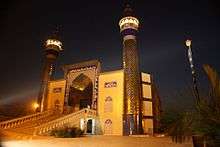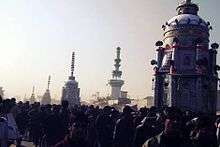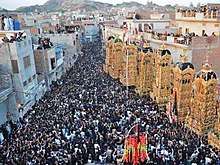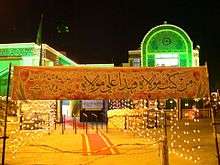Shia Islam in Pakistan
| |
|---|
 |
|
|

The Shia population in Pakistan is estimated as being 15% of the country's total population.[1][2][3][4][5][6][7][8][9] Pakistan is said to have a Shia population of at least 26 million, like India.[10][11][12] However, Vali Nasr claims the Shia population to be as high as 30 million.[13][14] A PEW survey in 2012 found that 16% of those who responded to its survey in Pakistan declared themselves as Shia.[2][13]
History
Historical accounts on the conversion of local people to the Shia Islam are not very clear and different opinions are present in this regard. However, what is most clear is that Indian city of Lucknow has remained a center of Shia Islam in South Asia for quite a while. After the division of British India in 1947, a great number of Shia Muslims residing in the Indian parts of subcontinent migrated to the newly formed state of Pakistan. While Shi'a Muslims have found a refuge in Pakistan, tensions between them and certain sections of Sunnis has resulted in the creation of Shi'a-specific organizations in recent years. In the past, Shias in this region of Pakistan have also faced persecution by some Mughal Emperors which resulted in murder of Shia scholar Qazi Nurullah Shustari also known as Shaheed-e-Thaalis, which means the "Third Martyr". Many Nawabs were among the Shias who were rulers in present-day India, Bangladesh and Pakistan.[15]
Political influence

Muhammad Ali Jinnah, the Quaid-e-Azam ("the Great Leader"), the founder of the state of Pakistan, was born into a Shia Ismaili family although later in life he followed Twelver Shia Islam.[16][17][18][19]
While in past few decades, to address the legal needs and political support of the Shi'a population in Pakistan organizations like Tehrik-e-Jafaria Pakistan and Imamia Students Organisation were formed, while Sipah-e-Muhammad Pakistan, a Shia militant group, was formed to deter the militancy against Shias by Sipah-e-Sahaba Pakistan as well as Laskhar-e-Jhangvi, Deobandi militant groups. Although the Sunni and Shia Muslims usually coexist peacefully, sectarian violence is carried out sporadically by radical groups.
When General Zia ul-Haq, the former military ruler of Pakistan, introduced new laws to make Zakat deductions mandatory for every Muslim during the 1980s, Tehrik-e-Jafaria held a large public demonstration in Islamabad to compel the government to exempt the Shia Muslim community from this law. This protest resulted in the "Islamabad Agreement" in which the government agreed to introduce a separate syllabus for Shia students in public schools, as well as exempt the Shia community from the Zakat law, since Shia consider Zakat as a personal tax (to be paid to the needy) not collectible by the state. According to one senior Pakistani journalist who witnessed these events, Iranian leader Ayatollah Khomeini played an important role in this agreement being reached, and he sought assurances from General Zia al-Haq that Shia demands would be met. A message from Ayatollah Khomeini was also read out to the Shia protesters in Islamabad in which he called for them to keep up their spirits.[20][21]
Problems
Shias allege discrimination by the Pakistani government since 1948, claiming that Sunnis are given preference in business, official positions and administration of justice.[22] Attacks on Shias increased under the presidency of Zia-ul-Haq,[22] with the first major sectarian riots in Pakistan breaking out in 1983 in Karachi and later spreading to Lahore and Balochistan.[23] Sectarian violence became a recurring feature of the Muharram month every year, with sectarian violence between Sunnis and Shias taking place in 1986 in Parachinar.[23] In one notorious incident, the 1988 Gilgit Massacre, Osama bin Laden-led Sunni tribals assaulted, massacred and raped Shia civilians in Gilgit after being inducted by the Pakistan Army to quell a Shia uprising in Gilgit.[24][25][26][27][28]
Pakistan Shia communities

Divisions within the Shia sect
Although the overwhelming majority of Pakistani Shia Muslims belong to Ithna 'ashariyah school, there are significant minorities of Nizari Ismailis (Aga Khanis) and the smaller Mustaali Dawoodi Bohra and Sulaimani Bohra branches.[29]
Notable Shia of Pakistan
Gallery



See also
References
- ↑ "Country Profile: Pakistan" (PDF). Library of Congress Country Studies on Pakistan. Library of Congress. February 2005. Retrieved 2010-09-01.
Religion: The overwhelming majority of the population (96.3 percent) is Muslim, of whom approximately 85 percent are Sunni and 15 percent Shia.
- 1 2 "The World's Muslims: Unity and Diversity". Pew Research Center. 9 August 2012. Retrieved 26 December 2016.
On the other hand, in Pakistan, where 16% of the survey respondents identify as Shia, Sunni attitudes are more mixed: 50% say Shias are Muslims, while 41% say they are not.
- ↑ "Religions: Muslim 95% (Sunni 75%, Shia 20%), other (includes Christian and Hindu) 5%". Central Intelligence Agency. The World Factbook on Pakistan. 2010. Retrieved 2010-08-24.
- ↑ Miller, Tracy, ed. (October 2009). Mapping the Global Muslim Population: A Report on the Size and Distribution of the World's Muslim Population. Pew Research Center. Retrieved 2015-10-07.
- ↑ "Pakistan, Islam in". Oxford Centre for Islamic Studies. Oxford University Press. Retrieved 2010-08-29.
Approximately 97 percent of Pakistanis are Muslim. The majority are Sunnis following the Hanafi school of Islamic law. Between 10 and 15 percent are Shias, mostly Twelvers.
- ↑ "Pakistan - International Religious Freedom Report 2008". United States Department of State. Retrieved 2010-08-28.
The majority of Muslims in the country are Sunni, with a Shi'a minority ranging between 10 to 20 percent.
- ↑ "THE TROUBLE WITH MADRASSAHS".
- ↑ "Early Warning Signs of Shia Genocide in Pakistan".
- ↑ Hussain, Javed; Ahmad, Jibran (July 26, 2013). "Suicide bombs kill 39 near Shi'ite mosques in Pakistan". Reuters.
- ↑ "Field Listing : Religions". The World Factbook. Central Intelligence Agency. 2010. Retrieved 24 August 2010.
- ↑ Tracy Miller, ed. (October 2009). "Mapping the Global Muslim Population: A Report on the Size and Distribution of the World's Muslim Population". Pew Research Center. Archived from the original on 27 March 2010. Retrieved 9 June 2010.
- ↑ Nasr, Vali (2007). The Shia revival : how conflicts within Islam will shape the future (Paperback ed.). New York: W.W. Norton. ISBN 0393329682.
- 1 2 http://www.pakistanchristianpost.com/detail.php?articleid=2731
- ↑ "The Shia Revival: How Conflicts within Islam Will Shape the Future". Vali Nasr, Joanne J. Myers. October 18, 2006. Archived from the original on 14 September 2012. Retrieved 2010-08-24.
Pakistan is the second-largest Shia country in the world, with about 30 million population.
- ↑ BBC News - Mughal Empire (1500s, 1600s)
- ↑ http://www.thefridaytimes.com/24122010/page27.shtml
- ↑ Ahmed, Akbar (2005). Jinnah, Pakistan and Islamic Identity: The Search for Saladin. Routledge. ISBN 9781134750221.
Although born into a Khoja (from khwaja or 'noble') family who were disciples of the Ismaili Aga Khan, Jinnah moved towards the Sunni sect early in life. There is evidence later, given by his relatives and associates in court, to establish that he was firmly a Sunni Muslim by the end of his life (Merchant 1990).
- ↑ Wolpert, Stanley (1984). Jinnah of Pakistan. New York: Oxford University Press. p. 18. ISBN 978-0-19-503412-7.
- ↑ "Would Jinnah have lived as a Shia?".
- ↑ http://www.ezsoftech.com/akram/shiasunniunity.asp
- ↑ http://www.aawsat.com/english/news.asp?section=3&id=16368
- 1 2 Jones, Brian H. (2010). Around Rakaposhi. Brian H Jones. ISBN 9780980810721.
Many Shias in the region feel that they have been discriminated against since 1948. They claim that the Pakistani government continually gives preferences to Sunnis in business, in official positions, and in the administration of justice...The situation deteriorated sharply during the 1980s under the presidency of the tyrannical Zia-ul Haq when there were many attacks on the Shia population.
- 1 2 Broder, Jonathan (10 November 1987). "Sectarian Strife Threatens Pakistan`s Fragile Society". Chicago Tribune. Retrieved 31 December 2016.
Pakistan`s first major Shiite-Sunni riots erupted in 1983 in Karachi during the Shiite holiday of Muharram; at least 60 people were killed. More Muharram disturbances followed over the next three years, spreading to Lahore and the Baluchistan region and leaving hundreds more dead. Last July, Sunnis and Shiites, many of them armed with locally made automatic weapons, clashed in the northwestern town of Parachinar, where at least 200 died.
- ↑ Jones, Brian H. (2010). Around Rakaposhi. Brian H Jones. ISBN 9780980810721.
Many Shias in the region feel that they have been discriminated against since 1948. They claim that the Pakistani government continually gives preferences to Sunnis in business, in official positions, and in the administration of justice...The situation deteriorated sharply during the 1980s under the presidency of the tyrannical Zia-ul Haq when there were many attacks on the Shia population. In one of the most notorious incidents, during May 1988 Sunni assailants destroyed Shia villages, forcing thousands of people to flee to Gilgit for refuge. Shia mosques were razed and about 100 people were killed
- ↑ Raman, B (26 February 2003). "The Karachi Attack: The Kashmir Link". Rediiff News. Retrieved 31 December 2016.
A revolt by the Shias of Gilgit was ruthlessly suppressed by the Zia-ul Haq regime in 1988, killing hundreds of Shias. An armed group of tribals from Afghanistan and the North-West Frontier Province, led by Osama bin Laden, was inducted by the Pakistan Army into Gilgit and adjoining areas to suppress the revolt.
- ↑ Taimur, Shamil (12 October 2016). "This Muharram, Gilgit gives peace a chance". Herald. Retrieved 31 December 2016.
This led to violent clashes between the two sects. In 1988, after a brief calm of nearly four days, the military regime allegedly used certain militants along with local Sunnis to ‘teach a lesson’ to Shias, which led to hundreds of Shias and Sunnis being killed.
- ↑ International Organizations and The Rise of ISIL: Global Responses to Human Security Threats. Routledge. 2016. pp. 37–38. ISBN 9781315536088.
Several hundred Shiite civilians in Gilgit, Pakistan, were massacred in 1988 by Osama Bin Laden and his Taliban fighters (Raman, 2004).
- ↑ Murphy, Eamon (2013). The Making of Terrorism in Pakistan: Historical and Social Roots of Extremism. Routledge. p. 134. ISBN 9780415565264.
Shias in the district of Gilgit were assaulted, killed and raped by an invading Sunni lashkar-armed militia-comprising thousands of jihadis from the North West Frontier Province.
- ↑ "Heart of darkness: Shia resistance and revival in Pakistan". Herald (Pakistan). 29 October 2015. Retrieved 14 February 2016.